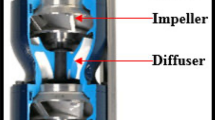Abstract
Large-diameter link lever butterfly valve is widely used in the transportation and adjustment of fluid media in the marine field. Because the opening and closing process of the link lever butterfly valve is mainly realized by the internal connecting rod mechanism, and it always exists in the fluid domain to affect the flow performance of the valve. It is necessary to optimize the connecting rod mechanism inside the valve. There are many structural safety problems in the connecting rod mechanism during the valve opening and closing process, such as large starting torque, vortex and turbulence near the valve disc causing resonance of the device, etc. This paper proposes a method to optimize the internal structure of the link lever butterfly valve to improve the flow performance of the valve while meeting the structural safety. The surrogate model is combined with finite element method (FEM) and computational fluid dynamics (CFD) analysis to improve optimization efficiency. The Response surface method (RSM) model is used to replace the Kriging model with insufficient accuracy, and build the combined surrogate model based on the global error criterion. The optimization algorithm combined with MIGA and NLPQL is used to obtain the best results of internal structural variables. The accuracy of the combined surrogate model is verified through FEM and CFD analysis. The results show that the flow performance of the link lever butterfly valve is greatly increased and combined surrogate model can effectively replace the finite element model to solve the optimization problem.












Similar content being viewed by others
Data availability
Not applicable.
Code availability
In order to implement the method described in the article more conveniently, provide the matlab code in the " Replication of results".
References
Caraballo SC, Rodríguez JO, Ruiz JL, Fernández RÁ (2017) Optimization of a butterfly valve disc using 3D topology and genetic algorithms. Struct Multidisc Optim 56:941–957. https://doi.org/10.1007/s00158-017-1694-4
Du B (2018) Research on the optimization design of In-wheel Motor with Ensemble of Metamodels. Dissertation, Hunan University [in Chinese]
Forrester AIJ, Sobester A, Keane AJ (2008) Engineering design via surrogate modelling: a practical guide. Wiley, Chichester
Gao YN (2016) Multi objective optimization of vehicle crashworthiness based on surrogate model. Dissertation, Chongqing University [in Chinese]
Gao YH, Wang XC (2012) a sequential optimization method with multi-point sampling criterion based on kriging surrogate model. Eng Mech 29(04):90–95 ([in Chinese])
Han ZJ, Liu EF, Liu ZY, Liu YY (2015) Research and optimization of flow characteristics of tri-eccentric butterfly valve based on CFD. Mech Des Manuf 12:185–189. https://doi.org/10.19356/j.cnki.1001-3997.2015.12.053.[inChinese]
He HW, Yi L, Peng JK (2017) Combinatorial optimization algorithm of MIGA and NLPQL for a plug-in hybrid electric bus parameters optimization. Energy Procedia 105:2460–2465. https://doi.org/10.1016/j.egypro.2017.03.708
Lee J-H, Song XG, Kang S-M, Park YC (2010) Optimization of flow coefficient for pan check valve by fluid dynamic analysis. American Institute of Physics, College Park
Lai YY, Jiang X (2012) Isight parameter optimization theory and detailed examples. Beijing University Press, Beijing
Li JW, Zhong S, Wang ZG, Pang LJ, Jia W (2014) Analysis of cracks in butterfly valve of Francis turbine. J Hohai Univ (nat Sci) 42(005):451–454 ([in Chinese])
Nguyen PTT, Manuel L, Coe RG (2019) On the development of an efficient surrogate model for predicting long-term extreme loads on a wave energy converter. J Offshore Mech Arctic Eng 141(6):061103
Pi NI, Lin G (2018) Discussion on formula of sealing specific pressure. Valve 1(215):36–41
Qiu JJ (2019) Ensemble of surrogated models based on hybrid measures and its applications in finite element model updating. Dissertation, Jiangsu University [in Chinese]
Song XG, Wang L, Baek SH, Park YC (2009a) Multidisciplinary optimization of a butterfly valve. ISA Trans 48(3):370–377
Song XG, Wang L, Park YC (2009b) Analysis and optimization of a butterfly valve disc. Arch Proce Inst Mech Eng Part E 223(E2):81–89
Sun W, Peng X, Dou J, Wang LT (2020) Surrogate-based weight reduction optimization of forearm of bucket-wheel stacker Reclaimer. Struct Multidiscp Optim 61:1287–1301
Wang F (2019) Research on robust multi-objective optimization of vehicle frontal collision based on combined agent model. Dissertation, Chongqing University [in Chinese]
Wu Y, Wu ZJ, Cao J, Wang P, He L (2019) Research on lightweight body-in-white based on isight response surface model. Beijing Automot Eng 06:1–6. https://doi.org/10.14175/j.issn.1002-4581.2019.06.001
Xu C (2009) Development of butterfly valve parametric design system and optimal design. Dissertation, Northeastern university. [in Chinese]
Zeng H, Su GY, Chang XS (2016) Numerical optimization design of specialty valve flow resistance coefficient. J Liaon Univ Technol (nat Sci Ed) 04:248–251. https://doi.org/10.15916/j.issn1674-3261.2016.04.10.[inChinese]
Funding
This work was supported by National key R&D program of China (Project Number: 2020YFB2007203).
Author information
Authors and Affiliations
Contributions
Not applicable.
Corresponding author
Ethics declarations
Conflicts of interest
The authors declare that they have no conflict of interest.
Replication of results
The code used in this article is shown in Table 5. "Check_Accuracy.m" is used to check the accuracy of the Kriging model. "Predictive_value.m" is used to calculate the predicted value. "NormalizedX.m" is used to normalize design variables. "Neglnlike.m" is used to calculate the negative number of concentration and likelihood. The RSM model in the combined surrogate model is directly generated in Isight. "Calculation.m" is used to calculate the Kriging model of the maximum deformation, the first-order natural frequency and the second-order natural frequency, and to check the strength of the valve. Combining "Calculation.m" and Isight software can easily optimize the valve (Table 8).
Consent to participate
Agree.
Consent for publication
Agree.
Ethical approval
Compliance with ethical standards.
Additional information
Responsible Editor: Seonho Cho
Publisher's Note
Springer Nature remains neutral with regard to jurisdictional claims in published maps and institutional affiliations.
Supplementary Information
Below is the link to the electronic supplementary material.
Appendix
Appendix
Rights and permissions
About this article
Cite this article
Wang, L., Zheng, S., Liu, X. et al. Flow resistance optimization of link lever butterfly valve based on combined surrogate model. Struct Multidisc Optim 64, 4255–4270 (2021). https://doi.org/10.1007/s00158-021-03060-5
Received:
Revised:
Accepted:
Published:
Issue Date:
DOI: https://doi.org/10.1007/s00158-021-03060-5




